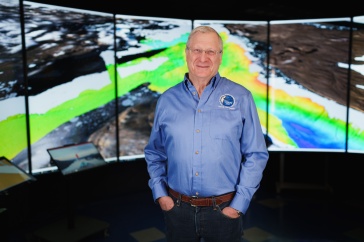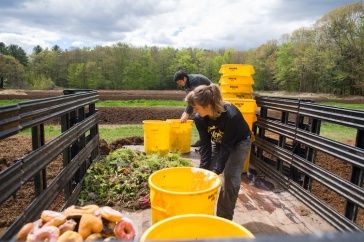Elizabeth Burakowski measures spectral albedo at a CoCoRaHS observer’s site in Bow, NH. (Photo: Jim Hilt)
University of New Hampshire Ph.D. candidate Elizabeth Burakowski was awarded the 2012 Wiesnet Medal for Best Student Paper at the 69th Annual Meeting of the Eastern Snow Conference (ESC) held earlier this month in Claryville, N.Y. She is the first UNH student to receive the award, which recognizes the best in current snow-related research being conducted by an up-and-coming student.
Burakowski’s paper detailed a volunteer, citizen-science effort she leads to collect snow reflectance or “albedo” measurements throughout New Hampshire. The albedo measurements are part of her central doctoral research analyzing the relationships between land use and changes in regional climate.
The ESC is a joint Canadian/U.S. organization with an international membership of scientists, engineers, snow surveyors, technicians, professors, and students working on issues related to snow and ice.
Elizabeth Burakowski scales a 120-foot tower to collect albedo measurements above a forest canopy in Durham. The canopy albedo measurements will complement the CoCoRaHS albedo measurements collected over deforested areas.
(Photo: Michelle Day, Institute for the Study of Earth, Oceans, and Space)
The albedo of a surface can influence local and regional climate by either reflecting sunlight to create a cooling effect or absorbing it to warm surfaces and surrounding air. For example, freshly fallen, deep snow reflects sunlight away from the ground, while darker surfaces – grass, a forest canopy, blacktop – absorb the sun’s energy and convert it to heat. A relatively snow-free winter, as was the case for the Northeast during 2012, had an impact on local to regional climate conditions.
Says Burakowski, a student in the interdisciplinary Natural Resources and Earth System Science Ph.D. program, “A lot of people understand conceptually what albedo is but they don’t know the term. I always use the white t-shirt analogy to explain it: if you want to stay cooler on a hot summer day you wear a white t-shirt, which reflects rather than absorbs and therefore has a high albedo.”
The citizen-science group making the measurements for Burakowski is part of the national Community Collaborative Rain, Hail, and Snow (CoCoRaHS) Network of volunteers that represents the largest provider of daily precipitation observations in the U.S. However, the NH contingent is the first CoCoRaHS albedo network in the US.
Burakowski’s award-winning paper, “Putting the Capital ʻAʼ in CoCoRAHS: An Experimental Program to Measure Albedo,” notes that despite record-breaking warm temperatures and below-average snowfall during the winter of 2012, the first pilot season of the effort successfully identified interesting relationships among albedo, snow depth, snow density, and land cover using the low-cost, volunteer approach to gathering reliable and accurate scientific data.
“The relationships among albedo, snow, and land cover will help improve models to accurately simulate wintertime climate and hydrological responses to changes in the surface energy budget,” Burakowski notes in her paper’s conclusion.
"Given that snow cover is one of the most varying components of the climate system annually and from year to year, it is critical that we understand how the albedo of landscapes are impacted by the presence or absence of snow", says David Robinson, a snow scientist at Rutgers University in New Jersey. Robinson also serves as the N.J. state climatologist and is a longtime member of the ESC.
Robinson adds, "Elizabeth's unique study has contributed interesting and exciting information that is increasing our knowledge of the subject. Thus, it is fitting that she receive the Wiesnet medal."
Of her overall doctoral thesis work Burakowski says, “We understand that recent winter warming trends are linked to greenhouse gases, but over the long term we still don’t yet know what impact the change in surface albedo has had on winter temperature. I aim to answer this question in my dissertation.”
Specifically, Burakowski adds, her dissertation work seeks to answer how much of the 1.5 degrees Celsius winter warming trend observed in New Hampshire since the late 1800s can be attributed to the large-scale reforestation that has occurred since then.
“It’s known that when a deforested landscape – such as the one settlers created in New Hampshire in 1870 – is covered with snow, it’s the equivalent of covering that landscape with a giant white t-shirt,” Burakowski says. “Today, forests have regrown and now cover nearly 85 percent of the New Hampshire landscape and this acts like a black t-shirt in winter, which may be a strong contributor to that significant warming trend over the last century and a half.”
Burakowski’s Ph.D. work is being funded through a National Science Foundation Experimental Program to Stimulate Competitive Research (EPSCoR) project titled “Ecosystems and Society.” The $20-million, five-year award to UNH will bring together researchers from around the state to better understand the environment and the complex interactions of the climate-ecological-human system as well as provide critical information for state decision makers.
UNH co-authors on Burakowski’s paper include research associate professors Cameron Wake and Jack Dibb of the Institute for the Study of Earth, Oceans, and Space (EOS), and assistant professor of geography and N.H. State Climatologist Mary Stampone. Wake won the Wiesnet Medal in 1987 while a graduate student at Wilfred Laurier University in Ontario, Canada.
To learn more about Burakowski’s CoCoRaHS project, see the NH EPSCoR’s brief video at http://www.youtube.com/user/nhepscor.



















































